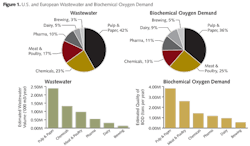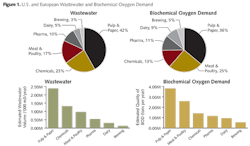By Stefan Urioc
BlueTech Research, a provider of water technology market intelligence, recently developed a comprehensive model for determining the quantities of wastewater and biochemical oxygen demand that some of the major industries are producing.
Focused geographically on the United States and Europe, the study examines industries that include pulp and paper processing and manufacturing, chemicals production, meat and poultry, pharmaceuticals production, dairy processing, and the brewing industry. The calculations were based on the volumes of wastewater generated per unit of product processed or manufactured.
BlueTech has identified a strong interest in more detailed understanding of the sub-sectors within industrial wastewater treatment, each with very different market dynamics, treatment trains, and pain points. Companies are looking for applications with higher margins for their technologies.
The industrial sector receives increasing attention from water technology providers due to opportunities presented by increasingly stringent regulations or growing production capacity, as is the case for craft brewing. Figure 1, for example, shows the U.S. and European wastewater and biochemical oxygen demand for the six industries identified.
The indices presented in Figure 2 were calculated by studying the value of economic activity per cubic meter of wastewater produced. The chemicals industry represents the largest sector in terms of the value of economic output and revenue generation, while the pulp and paper industry represents the smallest sector in terms of the value of economic output and revenue generation.
The research revealed that the pulp and paper industry generated the largest quantities of wastewater in comparison to the other industries, due to the large quantities of water used per unit of product and rare water reuse. However, the economic value of the pulp and paper industry is one of the lowest in comparison to the other industries analyzed.
The BlueTech Industrial Value of Wastewater Indices serves as an orientation for process and wastewater treatment technology providers who need to factor in the relative value associated with a unit of water to determine the price point each market can bear. Industries with higher economic values per unit of water are likely to be less sensitive to the cost associated with water solutions. This can also mitigate in favor of a greater openness in certain industries to measures that can provide savings in the costs associated with water management.
While industries do not have a choice in relation to environmental compliance with discharge limits, the openness to invest in technology or to implement cost-saving options may be influenced by the significance of associated costs relative to the overall value of the activity it is supporting.
BlueTech's Insight Report, "Industrial Wastewater Treatment & Water Reuse in Six Key Industries," envisages the market opportunities in industrial wastewater treatment to be in resource recovery, particularly non-product water reuse, energy recovery and biopolymer production. The report outlines several current water reuse industrial application examples in facilities such as Coca-Cola and breweries.
Given that industries utilize vast quantities of water in their production processes (e.g., mixing, cooling and washing), this report focuses on water usage within the aforementioned industries and the potential for water reuse within that particular industry. The report also investigates recovery of other resources such as energy, nutrients and biopolymer production.
The report also highlights innovative resource recovery technologies and approaches currently being applied in various industries. Examples include basic anaerobic treatment technologies that generate biogas, as well as advanced integrated treatment that combines anaerobic treatment with nutrient recovery.
About the Author: Stefan Urioc is a water technology market analyst and data scientist at BlueTech Research and leads the smart water practice area. Urioc holds a master's of science degree in environmental water management from Cranfield University and a master's degree in environmental engineering from the Agronomic University of Bucharest.




